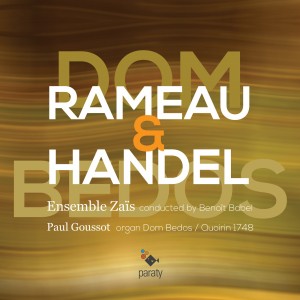
Handel’s concertos for organ and Rameau’s concert harpsichord pieces figure among the most original works in the keyboard repertoire of the 18th century.
This impressive dimension to Handel’s playing, this fullness recounted by Mainwaring, are in line with the aesthetic of the organ of Dom Bedos de Celles de l’Abbatiale Ste-Croix de Bordeaux.
Handel, being a seasoned traveler, was able to try out great instruments, notably the famous organ of St-Bavo de Haarlem, built by Christian Müller in 1735-1738, with a sumptuous organ chest sculpted by Jan Van Logteren including two open 16-foot organ towers. Handel made two trips to Haarlem: the first in 1740, then a second time in 1750, both times with the goal of playing the Müller organ. This organ had a resounding reputation in the eighteenth century, as did the organ of Dom Bedos de Ste-Croix de Bordeaux.
The Dom Bedos organ is one of the rare instruments in France in the 18th century equipped with a 32-foot manual organ stop, endowing the grand plein-jeu with an incredible depth.
Thus, in most of the slow and solemn movements such as the Larghetto of opus 4 n° 1 (HWV 289), the Andanteof opus 4 n°4 or the Adagio of opus 7 n°4 (HWV 309), the realisation of the figures of harmony reinforces the texture of the music. In the concerto in D minor HWV 309, we have preferred to replace the quick movement in D major – less adapted to the aesthetic of the Dom Bedos –with a movement entirely improvised on the 32-foot grand plein jeu, which takes up some elements of a version of this concerto for two organs, which has unfortunately disappeared.
This fullness can equally be heard in an improvisation on the grand fond of the organ, as a prelude to the Concerto in F Major, opus 4 n° 4, as practised by Handel in his time. His music is that of a curious and open-minded man, who never ceased to mix the tastes and styles of each culture. Moreover, his concertos for organ and orchestra were circulated in France by Michel Corrette and maybe even performed as part of his Concert Spirituel. The Dom Bedos organ of Ste-Croix thus proved to be the ideal instrument with which to record these Handel Concertos. Its colours, at once deep, majestic, brilliant, coppery but also suave, mellow, and clear, suit marvellously the musical language of the author of the Messiah.
The absence of any composition for organ by Rameau constitutes a large empty space and a great frustration for harpsichordists and organists of our time, since we know that Ramaeu, much like Handel, was a brilliant harpsichordist as well as being a brilliant organist. In his Memoirs, Jean-François Marmontel (1723-1799), encyclopedist friend of Voltaire and Rousseau, speaks of his stays in Passy at the property of Monsieur Alexandre Le Riche de la Pouplinière (1693-1762), patron and protector of Rameau.
In March, 1741, in Paris, Mercure de France announces the publication of “Pièces de clavecin en concerts, avec un violon ou une flûte, et une viole ou un deuxième violon » by Jean-Philippe Rameau. The work unites pieces from five groups under the title concerts. This publication deserves special attention. It is in effect the only work that this genius of opera and great music theoretician left us in the domain of chamber music. Already, the composer has met with success on the lyric stage. Rameau, then at the age of 58, prepares a representation of Hippolyte et Aricie (1742), Indes Galantes (1743) and a new version of Dardanus (1744). Two years before the Pièces de clavecin en concert, in 1739, he presents Dardanus and Les Fêtes d’Hébé at the Royal Academy of Music.
Some of these harpsichord pieces en concert seemed to us to find an echo in the universe of the organ of the Enlightenment and to suit perfectly an exectution on the organ. Thus, La Cupis naturally finds itself transformed into the Trio d’orgue, La Poplinière into the Duo de trompette de récit et de grosse tierce, La Forqueray into the fugue sur les anches, La Timide into fond d’orgue, récit de nazard … etc. It is not here a matter of concertos in the Italian form. You will not find here alteration between a solo instrument and the orchestra in which one responds to the other, but rather a real blend of instruments, a sort of mingled symphony, in the French style, where the musical discourse strolls at the heart of the orchestra instruments.

